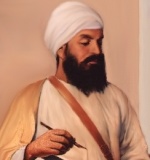Template:AOW316: Difference between revisions
Hari singh (talk | contribs) No edit summary |
Hari singh (talk | contribs) No edit summary |
||
| Line 6: | Line 6: | ||
He was the son of Bhai Deva Singh and Mata Rajadi, professional cloth printers of Nurdin village, also known as Sarai Nurdin, 7 km northwest of [[Tarn Taran]] in [[Amritsar]] district of the [[Punjab]], [[India]]. | He was the son of Bhai Deva Singh and Mata Rajadi, professional cloth printers of Nurdin village, also known as Sarai Nurdin, 7 km northwest of [[Tarn Taran]] in [[Amritsar]] district of the [[Punjab]], [[India]]. | ||
His father, though poor, was educated and well versed in the sacred texts. He sent his son, after preliminary education at home, to [[Amritsar]] where he became a pupil of [[Giani Sant Singh]] (1768 - 1832), a renowned man of letters and custodian of [[Sri Darbar Sahib]]. | His father, though poor, was educated and well versed in the sacred texts. He sent his son, after preliminary education at home, to [[Amritsar]] where he became a pupil of [[Giani Sant Singh]] (1768 - 1832), a renowned man of letters and custodian of [[Sri Darbar Sahib]]. | ||
After having studied [[Sikh Scripture]] and history, [[Sanskrit]] language and literature, poetics, philosophy and mythology at Amritsar for about 15 years, Santokh Singh moved to Buna, an old town on the right bank of the Yamuna in the present Yamuna Nagar district of [[Haryana]], some time before 1813. | After having studied [[Sikh Scripture]] and history, [[Sanskrit]] language and literature, poetics, philosophy and mythology at Amritsar for about 15 years, Santokh Singh moved to Buna, an old town on the right bank of the Yamuna in the present Yamuna Nagar district of [[Haryana]], some time before 1813. | ||
There he established himself as a writer, poet, and preacher. His patron was Dial Singh, also from a clothmakers' family and an old acquaintance of the poet's father, who was serving as an army officer under Sardar Hari Singh, chief of Buna. Here Santokh Singh wrote his earlier works, Nam Kosh, a versified Hindi translation of Amar Kosa, the famous Sanskrit dictionary, (completed in 1821), and Sri Guru Nanak Prakash, an epic poem consisting of 9,700 verses dealing with the life and teachings of Guru Nanak (completed in 1823). -----> {{aowf|Bhai Santokh Singh}} | There he established himself as a writer, poet, and preacher. <!-----His patron was Dial Singh, also from a clothmakers' family and an old acquaintance of the poet's father, who was serving as an army officer under Sardar Hari Singh, chief of Buna. Here Santokh Singh wrote his earlier works, Nam Kosh, a versified Hindi translation of Amar Kosa, the famous Sanskrit dictionary, (completed in 1821), and Sri Guru Nanak Prakash, an epic poem consisting of 9,700 verses dealing with the life and teachings of Guru Nanak (completed in 1823). -----> {{aowf|Bhai Santokh Singh}} | ||
Latest revision as of 18:23, 23 July 2012
Bhai Santokh Singh, (1787 - 1843) the noted author of six important literary works - Naam Kosh, Guru Nanak Parkash, Garb Ganjni Teeka, Balmik Ramayan, Atam Purayan Teeka and his magnum opus, Sri Gur Partap Suraj Granth aka Suraj Parkash, was born on 8 October 1787.
He was the son of Bhai Deva Singh and Mata Rajadi, professional cloth printers of Nurdin village, also known as Sarai Nurdin, 7 km northwest of Tarn Taran in Amritsar district of the Punjab, India.
His father, though poor, was educated and well versed in the sacred texts. He sent his son, after preliminary education at home, to Amritsar where he became a pupil of Giani Sant Singh (1768 - 1832), a renowned man of letters and custodian of Sri Darbar Sahib.
After having studied Sikh Scripture and history, Sanskrit language and literature, poetics, philosophy and mythology at Amritsar for about 15 years, Santokh Singh moved to Buna, an old town on the right bank of the Yamuna in the present Yamuna Nagar district of Haryana, some time before 1813.
There he established himself as a writer, poet, and preacher. .....More

